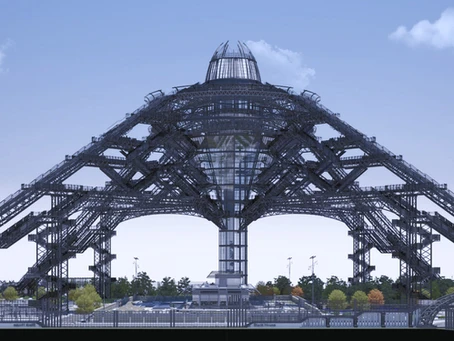The “Black House Museum” / Nuova Pyramid Museum also known as The 3°rd Eye Museum is the culmination of a centuries-long struggle to recognize the importance of the Igbo community in the social fabric of Nigeria and Africa in general. The idea is to literally bring back the ancient step pyramid of the Igbo people (Nsude pyramids)

in a new form, the pyramid was known to be built at the same historic period as the tombs of early Egyptian kings, which were bench shaped mounds called mastabas. First built by King Djoser’s architect, Imhotep by placing six mastebas, each smaller than beneath, in a stack to form a pyramid rising in steps.

The museum houses exhibit galleries, administrative spaces, theatre space, and collections storage space, etc. The “Nuova Pyramid Museum” rethinks the Nigerian role of what a civic institution could be in the modern world, offering new experience and engagement while accommodating an evolving collection and wide range of Igbo Ukwu Art, Nok Art, Ife Art as well as ancient Benin Art to unite Nigeria in one house as one family.
With PesArch approach to museum design, the Igbos (South East) and Nigeria as a whole prioritize cultural narrative and identity, giving form to the multitude of untold stories that provide a deeper understanding of our past and current contexts to inform our future. As such, it operates simultaneously as a museum, a memorial, and a space for cross-cultural community building. The design rests on five cornerstones: the “corona” shape at the pick and four major steps leading from the four corners of the building that represent the long journey of the Igbo’s west coast of Africa to the East coast of America; the extension of the building out into the landscape – the porch run round the square shape of the basement or external wall; and the steel filigree. To be situated on the Nike Lake Resort grounds the Black House Museum maintains a subtle profile in the landscape – more two flow is below ground – with six stores cylinder step case and six more 30° dodecagon shaped cones as well as six other sphere-shaped towers on top making it 18 flows above the ground level. The corona is designed to replicate a glass cup based on elements that the missionary brought to the Igbo land during the colonial expedition, closely matching Lord’s Supper and the 30-degree angles of the dodecagon shaped form represents the sunray to recall the ancient African spirituality “The Sun God” and the panel size and pattern has been developed using the Sun and its shining rays as a reference.
The entire building is wrapped in an ornamental glass-coated aluminum lattice (Basket = Nkata) that is a historical reference to Igbo craftsmanship. The density of the pattern can be modulated to control the amount of sunlight and transparency into the interior.
The North East entry is composed of the two motor ways that round up an external monument and a central water fountain. An extension of the building out into the landscape, the porch creates an outdoor room that bridges the gap between the interior and exterior.
Deeper inside or 12m deep, the setback is similar to other buildings shape. The underside of the porch roof is tilted sinkhole, reflecting the moving of a typical Igbo (African) way of life below. This covered area creates a microclimate where breezes combine with the cooling waters to generate a place of refuge from the hot harmmattan season . There is also an outdoor patio that is accessed from the ground floor of the building designed to reflect Kilimanjaro, upper and lower Egypt and the pigmentation is designed with symbols of the Igbo ancient writing “Nsibidi” through the North West entry is a 25m obelisk positioned in the middle of a cycle formed labyrinths .
Inside, visitors are guided on a historical and emotional journey, characterized by vast, column free spaces, a dramatic infusion of natural light, and a diverse material palette comprising pre-cast concrete, timber, and a glazed skin that sits within the bronze-coated aluminum lattice. Below ground, the double height history gallery and memorial space – the “oculus” – that brings light diffused by water, create a contemplative and monumental ambience. As one ascends through the museum, the views become pivotal: one circulates along the corona with unrivalled panoramas of the green areas, Lake Nike and Monument Grounds.


